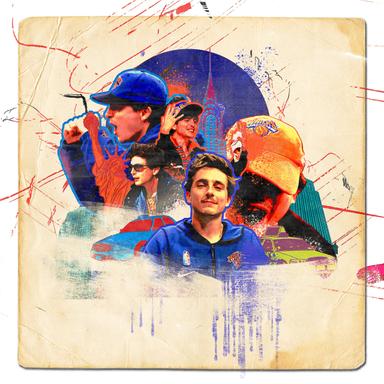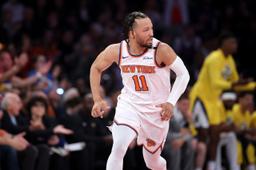You can feel it in the air alongside the subway steam, late spring microspores, and that unshakable hint of urine wafting up from the sidewalks. It doesn’t take a particularly discerning eye to tell when New York is head over heels for their Knickerbockers. The whole vibe is a bit like Mardi Gras, but shorter, and only after victories. A little squall can unfold anywhere.
I was riding the 4 train back from a Friday-night Yankees win in early May when the subway car started tilting to and fro like it just did the Rockaway. The tremors weren't for the Bombers: Knicks point guard and illusionist Jalen Brunson had, minutes earlier, launched his defender, ankles first, into the shadow realm—then called game, and series, from the top of the key. There’s nothing in city civic life quite like when the Knicks are on one. Strangers, usually in some combination of blue and orange, dap each other up as kin. Oscar nominees crowd-surf out the tinted windows of SUVs.
This is one in a select few exceptions to New York’s general disinterest in and repulsion of platonic fellowship. And there’s no one in these parts who gets the people going like Brunson.
JB’s game speaks. Haymakers take the form of summoned flybys and body-movement incantations. Death by a thousand jabs, feints, and fakes. As Clyde likes to say, the man percolates, devastates. Depending on the visitor, Brunson isn’t always the headliner at the Garden, but he’s uniquely capable of turning any outing into a home tidal swell. What he’s never had—as a pro at least—is a shot like the one he now confronts.
Blowing a 14-point lead in the home opener is not exactly in the Broadway script. Brunson, for his part, balled out for most of Wednesday’s Eastern Conference finals Game 1—though by the end of regulation he looked to be jonesing for a ventilator. New York might have just yacked up home court to the Pacers, but there’s still ample time to execute a deep clean. For a franchise long mired in abject failure and, up until even a few months ago, good-but-not-great overperformance, now is as ripe an opportunity as any.
Since the 6-foot-2 Brunson joined the Knicks in 2022, the franchise has deployed squads composed mostly of overachievers; a run of plucky underdogs that reinvigorated the most accursed major market in the sport.
For a team that went through 14 coaches and eight lead executives in 20 years, it was the first period of relative stability this century. Brunson improved his output rapidly: upping his points per game from 16 in his last year in Dallas to 24 and then 28.7 in his first two seasons in the Big Apple. (His scoring is slightly down this season, while his efficiency has mostly remained the same and his passing is slightly better.)
After trading for wingspan deity Mikal Bridges and 2015 no. 1 draft pick Karl-Anthony Towns in July and October, respectively, the Knicks, for the first time since the Pat Riley era’s Armani pugnacity, entered the season with enough talent to compete with anyone. For the first time in Brunson’s tenure, the franchise appeared to be upholding its pledge to attract high-level talent. They spent much of the next six months excelling offensively but backsliding on defense, hovering around the no. 3 seed in the standings, periodically wilting against the top teams in either conference. This had the double effect of not only girding onlookers against a postseason letdown but also allowing fans to comfortably reintroduce doubt as the primary animating force of Knicks patronage.
Then Games 1 and 2 of the Eastern Conference semifinals happened in Boston; the Knicks, led by Brunson, out-executed the defending champs in multiple fourth quarters; and a pathway to New York’s first conference championship of the century swelled into a six-lane highway. It is impossible to overstate Brunson’s centrality to these developments or how he has animated the long-tortured Knicks faithful. There are players who make the game look easy and ones who wear their ambition on their sleeve—and then there is Brunson, exuding the rigor of his craft while betraying little of his internal fire. On the court, you can’t help but admire how he plays the way he does, just as he can’t help but obscure it.
Brunson’s method of battle is simple attrition. A duel in which engagement is expressed via footwork, head fakes, and feats of balance as much as strength. His routes to personal hotspots on the court are serpentine in nature—hard-earned with every step. Brunson’s limitations have stuck to him as an ever-present burr at each stratum of the game that he’s reached: too short, too slow, too coverable. Each time he’s received a sentence, he’s mined a way out. Not because he’s impervious to the edicts of the sport around him, but because his art is a practice in reciprocity. Even though Brunson might leave a fight thoroughly scratched up, he’s leaving there with something.
As a ball handler, it’s never a matter of one move. He speaks, competitively, in bursts. Every twitch is a tussle for positioning. One little battle after another little battle after another. Jab steps are trapdoors. Pivots flick defenders loose like windshield wipers do gnats. Floaters spring from off-feet. He waits until the slightest wobble, then topples the defender into obscurity.
It is a sight to behold, if not always hoop-ethical. (Given Brunson’s lack of size, and the legitimate frequency with which he makes potent contact with the defender, it’d be a misjudgment to liken him to a plain free throw merchant.) The margins in his game are so thin: every angle begets an opportunity, every burst exposes a fissure. I’ve seen him leapfrog out of reach of the game’s longest wingspan—bounce adversaries off his hip or hold them in his pocket like the Chosen One. Brunson, on game day, is in a 48-minute flow state. Even when he’s not going about the task of conquering, he remains entranced.
It is no coincidence that the 28-year-old’s path as a pro speaks to a city of sports partisans that love nothing more than seeing the little guy, real and imagined, in themselves. Brunson, like many of his peers, was the product of multiple generations of hoop-obsessives, in and beyond his own bloodline. His father, Rick, played for the late, great John Chaney at Temple before carving out a career in the league. The elder Brunson, who transitioned to the sidelines after his nine-year playing career ended, used the very same baptism by fire that Chaney reared him with to forge his son’s game.
Hill sprints, backward in the summertime. Admonitions in dimly lit gyms. Weighted vests. Weak-hand dribble routines. Premature film study. It all proved enough to make Jalen a top-20 recruit, a two-time NCAA champion, but not to get him drafted in the first round, let alone the 2018 lottery. Throughout his career, the hurdles that Brunson has previously overcome have been, repeatedly, recycled as impending tripping points from level to level. In the scheme of life that ain’t necessarily the ingredient list for a bona fide underdog, but in the insular hyper-competitive world of pro hoops it certainly can be.
That Brunson dribbled his way out of every trap the hoop world set for him is part of his appeal today, but how he did so is just as central to his standing. Brunson’s stoicism—the blank stare that carries the cost of each of his movements—is the city’s favorite kind of canvas. There’s a reason folks have been comparing him to Jeter since his first months in blue and orange. “I know I’m not the most athletic; I don’t jump out the screen with talent,” Brunson once told reporters (a factory-made Jeter-ism if ever there was one). “I’m just a guy that gets it done.” Give the city the space to fill in your mythology as it pleases, and chances are it will. Add to that a nose for finishing games, standing tall, if not always victoriously, when other crooks get shook and you’ve got the making of an Empire State icon.
How much any of that will determine what happens against the Pacers this week and next isn’t entirely clear, but it’ll color how we remember the moment. Hard to brand you a closer when you’re so gassed in OT that you lose motor functions, allowing the All-Star the league respects least to bite Reggie Miller—with a dash of Rick James. Brunson isn’t the only one with more than a bit riding on holding steady at the Garden and stealing one in Indiana, but he is the only one capable of making it happen and the only head heavy enough to hold the city’s crown. Considering what’s popping at the moment on the other side of town, that’s quite the prospect.
Stan Van Gundy, on the broadcast for this series, once called Brunson the best “small player” he’d “ever seen” at hooping “off two feet.” If JB erases Wednesday’s mark, I’m not the only New Yorker who’d remove those last three words from the quote and leave it at that. On the court, Brunson’s never been better, and a generation of Knicks have never been closer. There’s a legend to be made in this city. Winning is tricky business, but expect the man to leave the stage with something, either way.





